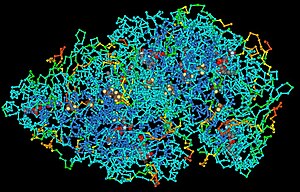Macromolecule

The term macromolecule by definition implies "large molecule". In the context of biochemistry, the term may be applied to the four conventional biopolymers (nucleic acids, proteins, carbohydrates, and lipids), as well as non-polymeric molecules with large molecular mass such as macrocycles. Macromolecules are synthesized through the process of polymerization, during which monomers (mono=single, meros=part) are assembled into large molecules - macromolecules.
Usage
The term macromolecule was coined by Nobel laureate Hermann Staudinger in the 1920s although his first relevant publication on this field only mentions high molecular compounds (in excess of 1000 atoms). [1]. At that time the phrase polymer as introduced by Berzelius in 1833 had a different meaning from that of today: it simply was another form of isomerism for example with benzene and acetylene and had little to do with size [2].
Usage of the term to describe different forms of large molecules varies among the disciplines. For example, while biology refers to macromolecules as the four large molecules living things are composed of, from the perspective of chemistry, the term may refer to aggregates of two or more macromolecules held together by intermolecular forces rather than covalent bonds but which do not readily dissociate.[3]
According to the recommended IUPAC definition, the term macromolecule as used in polymer science refers only to a single molecule. For example, a single polymeric molecule is appropriately described as a "macromolecule" or "polymer molecule" rather than a "polymer", which suggests a substance composed of macromolecules.[4]

Because of their size, macromolecules are not conveniently described in terms of stoichiometry alone. The structure of simple macromolecules, such as homopolymers, may be described in terms of the individual monomer subunit and total molecular mass. Complicated biomacromolecules, on the other hand, require multi-faceted structural description such as the hierarchy of structures used to describe proteins.
Properties
Substances that are composed macromolecules often have unusual physical properties. Although too small to see, individual pieces of DNA in solution can be broken in two simply by suctioning the solution through an ordinary straw. This is not true of smaller molecules. The 1964 edition of Linus Pauling's College Chemistry asserted that DNA in nature is never longer than about 5000 base pairs. This is because biochemists were inadvertently and consistently breaking their samples into pieces. In fact, the DNA of chromosomes can be hundreds of millions of base pairs long.
Another common macromolecular property that does not characterize smaller molecules is the need for assistance in dissolving into solution. Many require salts or particular ions to dissolve in water. Proteins will denature if the solute concentration of their solution is too high or too low.
High concentrations of macromolecules in a solution can alter the rates and equilibrium constants of the reactions of other macromolecules, through an effect known as macromolecular crowding.[5] This comes from macromolecules excluding other molecules from a large part of the volume of the solution, thereby increasing these molecules' effective concentration.
References
- ^ Staudinger, H.; Fritschi, J. Über die Hydrierung des Kautschuks und über seine Konstitution. Helv. Chim. Acta 1922, 5, 785–806.
- ^ The Origin of the Polymer Concept by William B. Jensen Journal of Chemical Education • Vol. 85 No. 5 May 624 2008
- ^ van Holde, K.E. Principles of Physical Biochemistry Prentice Hall: New Jersey, 1998
- ^ http://www.iupac.org/reports/1996/6812jenkins/6812basicterms.pdf
- ^ Minton AP (2006). "How can biochemical reactions within cells differ from those in test tubes?". J. Cell. Sci. 119 (Pt 14): 2863–9. doi:10.1242/jcs.03063. PMID 16825427.
{{cite journal}}: Unknown parameter|month=ignored (help)
